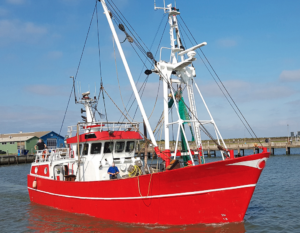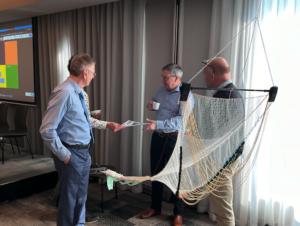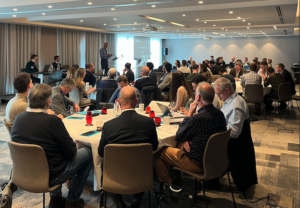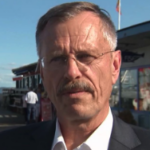I have been a proponent of EM for nearly 20 years. My journey to EM started with a new vision of how fisheries management could evolve. To quote a science report commissioned by the European Parliament in 2018: (EM) is…potentially the most adequate and cost-effective way to implement the discard ban and to move away from stringent technical rules into a more flexible management system focusing on impact and controllability.
But since that report was published, actual systemic change towards EM in the European Union has been glacially slow. In this article, I lay out my suggestions for breaking policy logjams and implementing future-focused fisheries management.
I see fisheries policy as a simple four-step mechanism: How much can be fished? Who should fish? How shall the fish be caught, and who is going to manage the fishing?
How much can be fished?
First, ensure the best assessment of fish stocks by setting single-stock maximum sustainable yield (MSY) total allowable catches (TACs) for a season, a year, or longer, depending on the stock situation.
I do not believe we are ready to implement ecosystem-based TACs that put trophic interaction into play. This is for two reasons: 1) We do not have enough scientific knowledge, and 2) A discussion of choices between fishing high or low in the trophic pyramid will open a policy discussion which we are not currently prepared for.
 I do not believe in TACs being set to counteract catch disparities that scientists may calculate for mixed fisheries. Rather, management and fishing methods should handle situations where fishing may result in choke situations. A multitude of solutions are available. And yes, I would rather accept the risk that some TACs may not be fully used than engage in the guesswork of fishermen’s adaptation to circumstances at sea. I’m well aware of the temptation to discard in cases of a mismatch between quota holdings and catches taken; my third step comes in here.
I do not believe in TACs being set to counteract catch disparities that scientists may calculate for mixed fisheries. Rather, management and fishing methods should handle situations where fishing may result in choke situations. A multitude of solutions are available. And yes, I would rather accept the risk that some TACs may not be fully used than engage in the guesswork of fishermen’s adaptation to circumstances at sea. I’m well aware of the temptation to discard in cases of a mismatch between quota holdings and catches taken; my third step comes in here.
So, my first priority for stock assessments at this point is to focus on and develop assessments on a single-stock basis.
ICES is aware of the flaws in assessments, including those stemming from lack of timeliness in data, and modeling that fails to address “unusual” fluctuations, such as climate. An ICES Working group is working to apply new technologies to improve this situation. Unfortunately, policymakers in the EU are not engaged in this process. High-level managers need to be very clear on their needs if we are to improve the situation. Technology now allows us access to real-time data and it is time to put new models to rigorous tests, instead of the tedious modeling, calibration and bench-marking of the existing advisory tradition. Where do we have an AI-based stock assessment test?
Who should fish?
Allocation of fishing rights is contentious. It does not have to be, but I will not discuss “who gets to fish” in this article. In the context of optimal use, however, transferability is indispensable in order to adapt fleet structures to long-term changes and to match actual catches with quota availability on a daily basis. In Denmark, a fisher having incidental by-catches for which he has no quota may land and sell the fish. He just has to lease-in the quota amount before the end of the year. He does that on a “home-banking system” administered by fisheries organizations that have worked flawlessly since 2007.
How shall the fish be caught?

“Precision harvesting” is the challenge: How do fishermen best catch their target species and avoid unwanted catches? Today the public authorities have assumed responsibility for this through the imposition of centralized prescriptive rules guiding fishermen to fish “sustainably.” Multiple layers of rules regarding fishing methods, use of gear, area, time at sea and fleet capacity are governing fishing. The result is an unacceptable waste of resources, an unsatisfactory economy and severe control issues. To achieve an optimal utilization of the resource the fisherman should have the choice of method in conducting his fishery according to the variability of the circumstances at sea. This freedom must be exercised within total catch limits accounted for through EM. With this boundary, we will see fishermen asking for the best possible way to catch their target species. And they may start by applying the manifold solutions awaiting on developers’ shelves.
Who is going to manage fishing?
In most enterprises, management is something done by the company. Not so in fishing. In the US, a combination of NOAA and regional councils decide how to fish and in the EU the Council of Ministers and the European Parliament detail the rules to follow. These rules are based take a “one-size-fits-all” approach, and most of the time they contradict fishermen’s economic interests.
In general, this policy has succeeded in improving fish stocks in the US, and to a certain degree in the EU. Fishing efforts have reduced over time, and reduced fleet capacity has secured an uptick in earnings.
Unfortunately, by setting bars too low and failing to actively engage fishermen’s skills and intellect, some politicians, scientists and environmental groups—especially in Europe—are “missing the boat” in fisheries management. The concept of “sustainability” has gone adrift from the Brundtland definition. For many environmentalists sustainability simply translates into “protection,” but sustainability is not about protection, per se. It is about stewardship, utilization and meeting human needs. Sound fish stocks are obviously a precondition for sustainable use. It is sad to see the EU claim of fish stocks being sustainably managed once an MSY target is met when large numbers of fish continue to be discarded and lost to both economic benefit and human consumption.
Technology now allows us access to real-time data and it is time to put new models to rigorous tests, instead of the tedious modeling, calibration and bench-marking of the existing advisory tradition.
The solution is to apply a free-enterprise approach, unleashing fishermen’s skills and their will to innovate. Make the fisherman accountable for his total catch. This will incentivize him/her to fish optimally; allow for higher quotas as all catches will count; and remove the need for straitjacketed top-down management of the fishery. In Denmark, the free choice of gear has been shown to improve catches and reduce bycatch. When accountable for his or her entire catch—as documented by EM, observers, or agreed-upon advanced statistical methods— the fisherman becomes a responsible co-manager.
The US and the EU have followed different paths in policy. Early on the US administration succeeded with an approach of “pressure and persuasion” to get constructive cooperation with fisheries organisations in order to implement EM as a mandatory system that fishermen could work with, and see benefits from. Likewise in British Columbia, Canada. What I see however is system improvements, not a system change. Prescriptive management is still the game.

The EU has made a fundamental change in policy, from a discard regime to full accountability. I quote the Basic Regulation: “all catches count against quotas and must be accurately documented for example by CCTV.” But the EU has not delivered on the implementation. The reason is that the EU fisheries policy suffers from the “lowest common denominator disorder”. When a fisher discards unwanted catches and continues fishing for the most valuable fish, he gets the best deal for himself and lets the commons pay for the resulting overfishing. If he instead counts all catches against his quota and document this, as he should, he must use and develop selective fishing practises and take advantage of quota transferability to continue a mixed fishery with a quota holding for all species caught in that fishery. A more challenging task. The move from optimising mixed catches by discarding to optimising by selective practices calls for innovation in fishing methods and freedom for fishermen to develop best practices. So far, EU-fishermen not ready to change their behaviour have had the bigger ear from politicians, and the EU has largely given up on the core legal principle of accounting for what is harvested.
A mandatory EM system may not work in the EU. It will be subverted by fishermen and Member States who “care for their fishermen and their traditions.” And there is not enough support for a voluntary incentive-based system as it is thought to leave some fishermen behind in the development towards a true sustainable fishery.
From 2009-2015 Denmark and the UK conducted the largest trials on sustainable fishery in the history of the EU. As part of the traditionally yearly regulation on quotas, fishermen who documented and counted all catches would get a quota top-up reflecting the “normal” level of discarding. The results of these trials lay behind the aforementioned science report stating that, the system seemed to be the most adequate and cost-effective way to implement full catch accounting and to “relax REM vessels from most technical rules against the full documentation and monitoring of their catches, including:
- Full quota top-up for REM vessels and reduced or no top-up for non-REM vessels
- Free choice of gear for REM vessels – except for rules related to bottom impact and bycatches of protected species
- Simplified exemptions for REM vessels
- The main point is that catches are “recorded and accounted for”
My conclusion on policy engagement to unleash EM/REM potential
In short: To obtain sustainability in the true sense, fishermen must be accountable and have the freedom to optimize their results. The prerequisite for this is full catch documentation, where EM stands out as the only realistic and efficient solution.
I’m confident that the US and Canada may further improve fisheries management within the existing framework. However, tapping into the opportunities offered by a free enterprise approach is likely to improve utilization of the resource and to create a user-driven demand for new methods and technologies beyond what is possible under the existing regime.
Unfortunately for the EU the reformed legal basis and the practical fishery have not found a place to meet. EM is on the table with a limited mandatory model. Incentives are not part of the deal and the chance of success is therefore difficult to see.
The solution is to apply a free-enterprise approach, unleashing fishermen’s skills and their will to innovate.
The UK is still in a transitional phase. The policy approach is centralized management based on a close and productive dialogue with the industry. The UK has pledged to account for all catches, but it remains to be seen if an unaccounted discarding will stop. EM has been on the agenda for a number of years, but there is no clear sign of an initiative that may link EM with the benefits of free enterprise.
Changing a fisheries policy is politically sensitive, technically complex and exhausting. The move from prescriptive management to a free enterprise approach is not easily done and certainly not with an ambition to do it across fisheries in general in one piece of legislation.
Therefore, the obvious solution is to let the industry itself do the pull. Give fishermen who want the chance to move forward the option to choose a management solution based on quota top-up, free choice of gear and full EM-documentation of all catch activities. Experience shows that fishermen will queue up for such an offer. Reserve existing prescriptive management for remainers, and observe the development. I have no doubt about the force of such a step.
For the US it is a question of willingness to take an already positive development into the next conceptual level.
The European Council of Ministers is acting as the guardian of delayed progress. It is a question of political will to move away from the present lowest common denominator policy. In the end, NGO pressure, market forces and EM successes around the world may be the forces that initiate a change.
− − − − − − −
Also see Fishing News: A new approach to selective fishing, March 24, 2024
Mogens Schou is partner of AquaMind, advising on fisheries management. In his former capacity of the ministers adviser he designed the political, legal and operational basis for large scale REM trials in EU and Danish regulations 2008-2016. The principle of full catch accountability is now a cornerstone of the reformed CFP (Common Fisheries Policy), and results based management (managing catches not methods) is evolving from that. His main interest is to develop REM based on the needs of management and to re-define management and biological advice to take account of the new opportunities offered by fully documented fisheries and real-time, high resolution data from commercial fishing.


